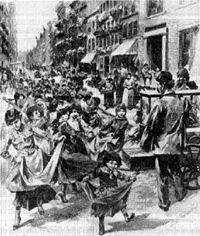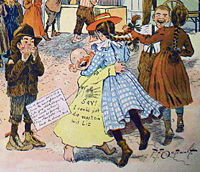Spiel

The spiel (pronounced spẽl or shpẽl) is an obsolete historical dance from late 19th and early 20th century New York, which originated from the working-class of the Lower East Side and the Bowery. It was mainly performed by young women and children and became popular in the 1880s. The spiel was usually danced to music of the street organ in an uptempo triple meter, similar to the more formal European waltz, and its style was generally described as frenetic, twirling and ecstatic.
Etymology and meaning of spiel
Until the 1880s a vibrant German culture had developed in New York. The verb "to spiel", originally from German spielen ("to play", "to perform"), was at first used to denote the playing of circus music (spieling),[2] often performed on organs. The hand-organ of the hurdy-gurdy man accompanying the spiel may have attracted the earlier circensial term, or spiel was based on the imperative Spiel! of German immigrants ordering the organist to play his instrument. It eventually entered the street vernacular of the East side and the dance halls of the Bowery, often with spieler as the general term for "dancer".[3] In a more specific sense the term spieler usually described the women and children dancers, seldomly the male partner of the dance-hall spiel. The term spiel was soon applied as a pars pro toto for the sidewalk and dance-hall spiels as well as related dances like the tough dance (v.i.).

The original sidewalk spiel
The sidewalk spiel was mostly danced by young girls and children. James W. Blake's lyrics of New York's unofficial song of the time, The Sidewalks of New York, alluded to the spieling by referencing the waltzing dance of children to organ music on the city's sidewalks.[5] Not unlike the victims of the legendary German pied piper, the children would gather behind the hurdy-gurdy man and follow him from block to block, sometimes dancing an often frenzied spiel for several hours.[6] The rhythmic dances of the girls were a "familiar thing to see […] on the East Side".[7] Apparently only one testimony by former spieler Marie Jastrow has survived, which describes the movements of the sidewalk spiel around the year 1900:
[…] foolish, little tripping dances, they were. First on one leg, twirling the other one around and around to the rhythm of the music. Then, a change to the other leg, when the whole process was repeated.[8]
Dance-hall spiel

Dances like the spiel functioned as a means and symbol of liberation. Like feminism, which was at first a movement of the petite bourgeoisie, the dances originated from the working-class and helped the women overcome Victorian social constraints, which emancipated them earlier than women of the middle- and upper-class.[10] The dance-hall spiel usually paired female and male partners, whereas the former was often swung high off the floor. Hutchins Hapgood commented on the dance-hall variant, which quickly developed from the sidewalk spiel:[11]
The dance-hall is truly a passion with working-girls. The desire to waltz is bred in the feminine bone. […] Some of them dance every night, and are so confirmed in it that they are technically known as "spielers".[12]
The culture of the dance-hall spiel was mentioned in many contemporary songs, e.g. The Spielers by J. L. Feeney[13] or in a popular waltz song of 1894:
My Pearl is a Bowery Girl
She's all the world to me.
She's in it with any the girls 'round the town,
And a corking good looker, see?
At Walhalla Hall she kills them all
As waltzing together we twirl.
She sets them all crazy, a spieler, a daisy,
My Pearl's a Bowery girl.[14]
Tough dance

LATER.
Spiel's end
The girl dancers of the sidewalk spiel remained "an enduring folkloric image of New York from the 1880s to around 1910", depicted e.g. on paintings by George Luks and Jerome Myers[16] and referenced in other works of art, e.g. in cartoons (v.s.). The street dance of the children and young working women vanished quickly, when street-organs became frowned upon and their owners debarred during the time of the First World War,[17] while its dance-hall variants were gradually replaced by more favored dances.
Notes
- ↑ Hester Street, near Allen: children and young girls dancing the spiel to the organ music of a hurdy-gurdy man. Originally published in Leslie's Weekly, 28 March 1895. From the private collection of Allen IL, reproduced in Allen 1993, 208, fig. 17.
- ↑ Approx. 1870; cf. Harper D. 2001. Online Etymological Dictionary. s.v. "spiel (n.)".
- ↑ Allen 1983, 2–6.
- ↑ Amateur Dime Museum (1896): cartoon by Richard Felton Outcault. Originally published in New York Journal, 04 October 1896.
- ↑ Hapgood 1910, 21.
- ↑ Gold 1930 (1984), 51.
- ↑ Hapgood 1910 131–35 (135).
- ↑ Jastrow 1979, 166.
- ↑ Pl. 27: Scott E. 1892. Dancing as an Art and Pastime. London: George Bell & Sons.
- ↑ Allen 1993, 66.
- ↑ Hapgood 1910, 135: "When those little girls grow older and become shop-girls they often continue to indulge their passion for the waltz."
- ↑ Hapgood 1910, 135.
- ↑ 1880s; sung to the tune of Sweet Forget-Me-Not:
They go to parties and soirees, and almost every ball;
You're sure to find the 'spielers' there who take the shine of all. - ↑ From the song "My Pearl Is A Bowery Girl" (1894; lyrics: William Jerome; music: Andrew Mack).
- ↑ Two young girls dancing a sidewalk spiel: painting by George Luks (1905).
- ↑ Allen 1993, 207 sq.
- ↑ Shackleton 1917, 247.